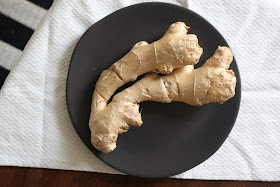Exciting Ingredients Part 5: Ginger
Welcome back to Tiny’s Kitchen! Over the holidays, Tiny had a lot of fun
cooking and catching up with her friends and family. But with the winter chill, she has come down with a bit of a scratchy throat. When her good friend Lydia decided to make
some soothing honey ginger tea to calm Tiny’s cough, they got to talking about
all of the wonderful ways the world uses this spicy tropical root.
A lovely, flowering plant, native to south China, Zingiber officinale has been used as a
spice and a medicinal plant since at least as early as 220 BCE. It has since spread the world over, and
ginger is now cultivated in subtropical regions around the globe. It is known to be anti-inflammatory and anti-microbial.
Chinese, Korean, Japanese, Vietnamese, Indian, South American, and Caribbean cooks, to name just a few, use it in savory and sweet dishes and beverages for its spicy and fragrant flavor. North American and European bakers use it dried, candied, or preserved, as a confection or in cakes and cookies.
Chinese, Korean, Japanese, Vietnamese, Indian, South American, and Caribbean cooks, to name just a few, use it in savory and sweet dishes and beverages for its spicy and fragrant flavor. North American and European bakers use it dried, candied, or preserved, as a confection or in cakes and cookies.
When cooking with the fresh root, Tiny likes to peel away
the papery skin with the side of a spoon, and slice or grate it across the
stringy grain. It keeps well in the fridge,
wrapped in paper towels and a plastic zipper bag, or tightly wrapped in the
freezer. The dried spice, so handy in
baking, loses its freshness quickly; buy it in small quantities and discard any
unused powder after 3 to 4 months.
If you’d like to try a zesty side vegetable dish, these ginger garlic green beans are a yummy warm option.
 This easy ginger-scallion sauce is delicious with grilled chicken or vegetable stir-fry. Or try it on Tiny’s salmon lettuce wraps.
This easy ginger-scallion sauce is delicious with grilled chicken or vegetable stir-fry. Or try it on Tiny’s salmon lettuce wraps.
If you’re a fan of sushi and sashimi, try making your own sweet pickled ginger, a classic Japanese accompaniment to fish and rice.
Poach some pears in ginger beer! The
non-alcoholic spicy-sweet drink makes a perfectly seasoned poaching liquid for
a light fruit dessert (or special occasion breakfast). If you don’t feel like fussing with the
vanilla custard, leave it out; the pears are perfectly lovely on their own.
These chewy nonfat cookies from David Lebovitz have an extra kick from both powdered
and candied ginger root. They are
marvelous for ice cream sandwiches or on their own as a light dessert.
For a traditional Indian spiced tea, try this chai masala. Loaded with fresh ginger,
cardamom, and milk, it will warm you right up on a chilly morning.
If you prefer a non-dairy, non-caffeinated
brew, give Lydia’s recipe a try! She
has found it soothing for sore, scratchy throats and tummy aches alike, but
Tiny thinks it is tasty enough to drink all winter long.
Lydia’s Honey Ginger
Brew
1 ½ cups water
2-inch piece of fresh ginger root, peeled, sliced thin
1-2 tablespoons honey
1-2 tablespoons fresh or bottled lemon juice
 Bring the water to a boil in a small saucepot. Add the ginger, cover the pot, and turn off
the heat. Set a timer for ten minutes, and
then strain the infusion into a teapot or 2 mugs. Add honey and lemon juice to your taste;
Lydia likes to use both!
Bring the water to a boil in a small saucepot. Add the ginger, cover the pot, and turn off
the heat. Set a timer for ten minutes, and
then strain the infusion into a teapot or 2 mugs. Add honey and lemon juice to your taste;
Lydia likes to use both!



No comments:
Post a Comment